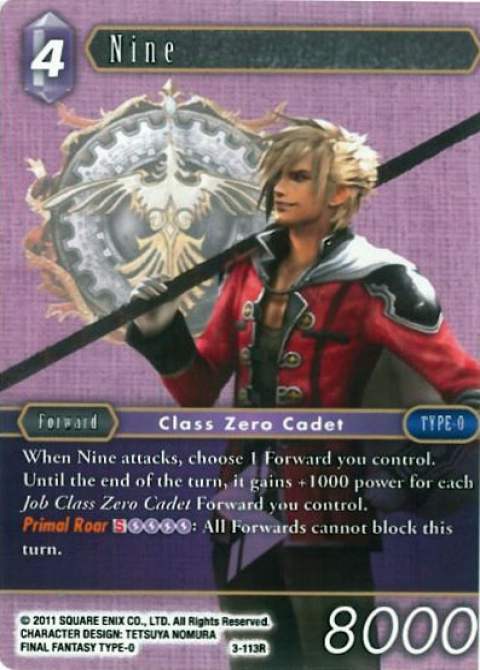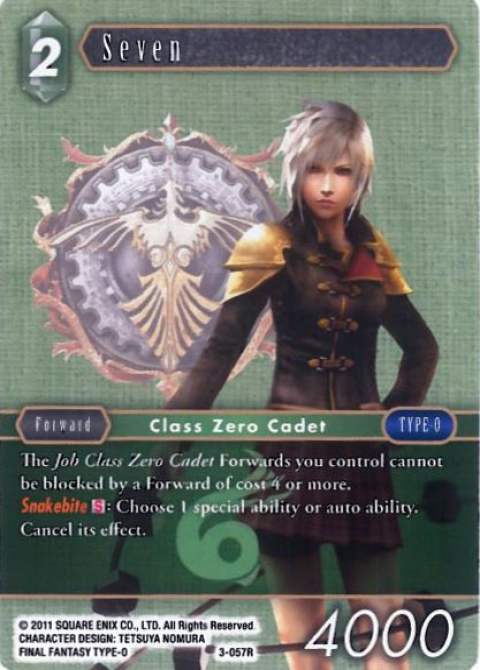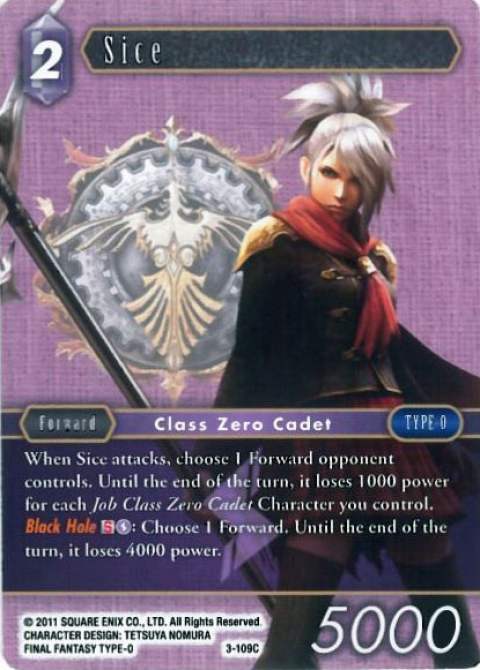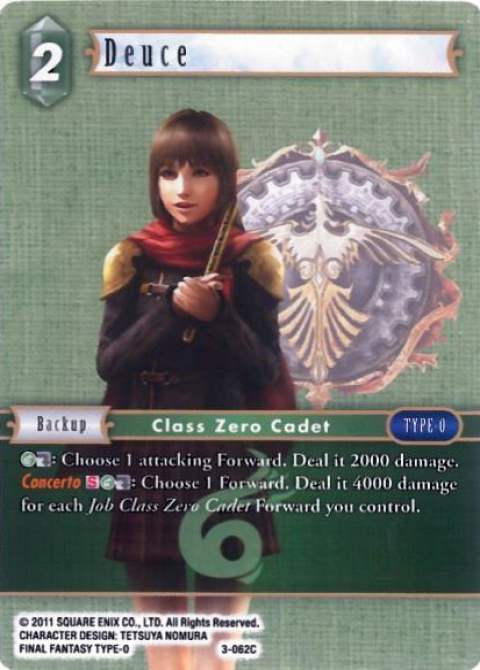
With OPUS III a new Final Fantasy TCG expansion set we can also buy two different FFTCG Starter decks. There is a Final Fantasy Type 0 Starter deck which is a Lightning/Wind aggro deck and Final Fantasy IX Starter deck which is a Water/Fire control deck. All decks contain cards from OPUS I, OPUS II, OPUS III, some of the cards can only be obtained by getting the Starter decks (or can still be opened as premium foil in OPUS III packs, but that's pretty rare). Some of the OPUS III cards have an alternate image (at least Rem looking like a peaceful student and Amarant going berserk) which can't be obtained in booster packs. Each deck also contains quick rules sheet, paper game mat, decklists of the five Starter decks and strategy guide for the OPUS III starter decks.
If you've never heard of Final Fantasy TCG I wrote an introductory article some time ago. You can find the article on my blog as well Final Fantasy Trading Card Game. It is a certainly good card game with nice mechanics and I'd recommend you to try it out if you get the chance. The following review if for those that already have some knowledge of the game.
Final Fantasy Type-0
FF Type-0 starter deck is a tribal deck. Many of the Characters in the deck have a job "Class Zero Cadet". The cards then have effects that either check for the job or their abilities are dependant on the number of job Class Zero Cadets etc. For example one card pumps a Forward by 1000 for each Class Zero Cadet under your control.
The decklist is as follows
| 3 | Ace | 3-153-S | Light | Forward |
| 3 | Queen | 3-151-S | Lightning | Forward |
| 3 | Nine | 3-113-R | Lightning | Forward |
| 2 | Chocobo | 1-075-C | Wind | Forward |
| 2 | Chocobo | 1-076-C | Wind | Forward |
| 2 | Ninja | 1-078-C | Wind | Forward |
| 2 | Dragoon | 1-148-C | Lightning | Forward |
| 2 | Dragoon | 2-148-C | Lightning | Forward |
| 2 | Seven | 3-148-C | Wind | Forward |
| 2 | Eight | 3-051-R | Wind | Forward |
| 2 | Sice | 3-109-C | Lightning | Forward |
| 3 | Rem | 3-072-R | Wind | Backup |
| 3 | Moogle (Class Zero) | 3-150-S | Wind | Backup |
| 3 | Arecia Al-Rashia | 3-097-R | Lightning | Backup |
| 2 | Evoker | 1-068-C | Wind | Backup |
| 2 | Black Mage | 1-130-C | Lightning | Backup |
| 2 | Summoner | 1-138-C | Lightning | Backup |
| 2 | Ninja | 2-115-C | Lightning | Backup |
| 2 | Deuce | 3-062 | Wind | Backup |
| 2 | Ramuh | 1-143-C | Lightning | Summon |
| 2 | Cyclops | 2-107-C | Lightning | Summon |
| 2 | Diablos | 3-061-R | Wind | Summon |
Type-0 deck is a fast aggro deck of a swarm type. The last damage point or points it is capable to deal through either certain special abilities or Forwards with Haste. This deck features some good backups with good abilities. Moogle Class 0 is actually a good backup in this deck. It pumps all your Job Class Zero Cadet Forwards by 1000 which is a very strong effect in this deck. I'm not a fan of this kind of effects in general, but this deck really needs it and makes it way more powerful.
The 'main Forward' of the deck is 6CP Light Ace. I was very surprised by what the card does because it just seemed too good to be true. "When Ace enters the field, you may play 1 Job Class Zero Cadet Forward from your hand onto the field. When Ace is put from the field into the Break Zone, choose 1 Job Class Zero Cadet Forward other than Card Name Ace from your Break Zone. Add it to your hand." Ace may be a high cost card but in reality your paying for two cards instead of one which can create a huge tempo swing (especially if the other card is Nine). When Ace dies, you can return a Job Class Zero Cadet Forward to your hand which means that Ace doesn't really cost anything. These are both very strong effects in any TCG or CCG so the card can't be bad.

Nine is the primery beater in this deck. It is a Lightning Forward for 4 CP with Power 8000. When Nine attacks it can make a Forward bigger by 1000 Power for each Job Class Cadet Forward under your control which makes him either very big and hard to block or can make on of the 'small' Forwards relatively big. This card reminds me of Wakka rrom the Final Fantasy X starter deck but the card doesn't seem to be that powerful (maybe also because there is no Minwu in these colors which make Wakka invincible, at least what concerns combat damage). Nine's special ability can win a stalled game out of nowhere (SLLLL: All Forwards cannot block this turn) but so far I haven't had the chance to use it yet.

Seven is a very interesting card, because it has two very strong abilities attached to it. Type 0 is a tribal swarm deck and this means that it can die to global removal effects like Shantotto for example. There's not so many cards like this yet but they mean GG for this deck. Seven's ability can counter a Special or auto-ability. Her static ability says that all Forwards under your control cannot be blocked by Forwards with cost 4 or more. The majority of relevant (see good) Forwards (unless they are Warrior of Light or Zidane) have the cost 4 (or more). This deck doesn't really have strong Forwards this a pretty good ability and your opponent won't be happy to see Seven in play unless they are also on some kind of a Swarm deck.

Sice seems to be a good constructed card in theory so I will have to try playing with it more. Sice needs some support though in the form of either abilities on Characters or Summons. The Starter deck has Ramuh as one of the possible support cards and Diablos which is actually an overpowered card (at least seems so!). Sice costs 2CP and has Power of 5000. Whenever she attacks, she lowers the power of an opposing Forward by 1000 for each Job Class Cadet under your control. Thanks to her, you can deal with big Forwards like Amarant for example (during the turn it can't still use it's ability)

Diablos is a Summon which always reminds me one epic battle I had the opportunity to experience in one of the Final Fantasy games. Its Gravity ability, other forbidden magic and regeneration always made all the battles quite difficult for me. Diablos Summon battles are the ones I remember the most. I hoped that Diablos in FFTCG would be some awesome card. When I read the card I was like "WHAT? I can play this card for free?". Yes, under some conditions this card doesn't cost anything. It is also a removal spell which makes it a future staple in my eyes. It deals damage to a Forward based on the number of Characters under your control. If you have a Job Class Zero Cadet Forward under your control you can activate up to 3 backups making it 'cost' 0. This card just seems to be pretty insane.

Deuce is a Backup for 2CP. I find 2CP backups very important and ones that have a good ability are even stellar. Deuce certainly falls into this category. This Class Zero Cadet can ping an attacking Forward for 2000 damage or she can also double as a one time removal. It's the best Type-0 tribal Backup and you certainly want to play 3 of it. Rem is similar to Lightning backup Sage which certainly showed up to be good. This one's ability is actually an EX burst one!
If you'd be thinking about upgrading this deck, you should get rid of the basic cards like Summoner, Evoker, Ninja, Dragoons, Chocobos etc. Instead you can put in Red Mage that gives Haste for L and Maria that pumps all your Forwards for 1000. And of course add a third Deuce.
Concerning Forwards. I'd think about adding Amon and any all jobs Bartz. This deck needs to go through at a certain point and Nine's ability is not something that I was able to use. I'd fancy a good tap effect or more hasty but reasonable Forwards. Amon is an idea card because it has a decent body and it taps when it enters play AND when you need it later. Unlike Queen it can be played or used anytime you want. The other possibility in which direction this deck could go is by being able to deal the remaining damage and dependent more on Sice. This would mean playing Forwards like Rygdea from FFXIII Starter Deck or Onion Knight (1-125-R) but I'm not honestly really a fan of that. Lightning/Ice tempo decks never needed to kill often, usually just once per game (in the later stage of the game). The deck could possibly use more Forwards with the Haste ability but thanks to Red Mage you don't really need to specifically look for such Forwards. It is a nice thing to have a few so you can produce two hasty Forwards in one turn and thus deal the remaining damage. I'd even play Queen from OPUS III if I would have difficulties finding better Forwards to play. She's more expensive than the Starter deck one with Power 7000, usually has First Strike (so good with some ping abilities) and her Special ability allows to deal 1 unblockable damage. 3CP and 4CP 'vanilla' Bartz is also a Job Class Zero Cadet which means that it can suddenly be a very powerful card for low cost.
As for Summons. I wasn't fan of Ramuh. It always messed up my sources and it didn't usually kill anything. Diablos is an auto-include. You want 3. Cyclops is good with the bunch of low power Forwards. This also can turn Sice into a Forward killer. As noted above this is also the kind of a deck that sometimes needs to kill something. In this case you don't need to worry about really big Forwards usually but you need to deal with some costing 4 (or less). For that we have Odin (1-123-R). If you'd be going for cards like Rygdea you certainly do not need to run the card Ramuh.
I'd say that Type-0 starter deck is the best of the five. It seems that with little bit of tweaking this can become a tournament deck. I don't know what will change with OPUS III cards but in the earlier metagame Lightning was well positioned. The Lightning part either supported by Wind or Water can be very efficient.
Happy tweaking!
S'Tsung













